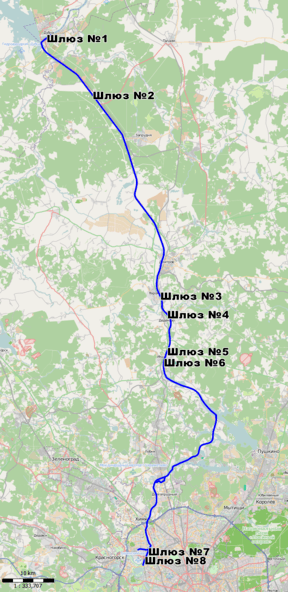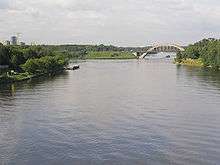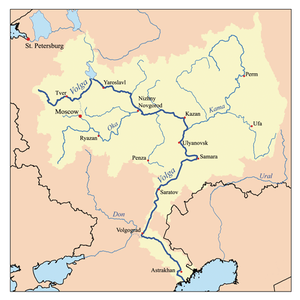Moscow Canal
| Moscow Canal | |
|---|---|
 Schematic map of the Moscow-Volga canal | |
| Specifications | |
| Length | 79.6 miles (128.1 km) |
| Locks | 8 |
| Maximum height above sea level | 531 ft (162 m) |
| History | |
| Former names | Moskva-Volga Canal |
| Date completed | 1937 |
| Geography | |
| Start point | Ivankovo Reservoir |
| End point | Moskva River |
The Moscow Canal (Russian: Кана́л и́мени Москвы́), named the Moskva-Volga Canal until 1947, is a canal that connects the Moskva River with the Volga River. It is located in Moscow itself and in the Moscow Oblast. The canal connects to the Moskva River in Tushino (an area in the north-west of Moscow), from which it runs approximately north to meet the Volga River in the town of Dubna, just upstream of the dam of the Ivankovo Reservoir. The length of the canal is 128 km.
It was constructed between 1932 and 1937[1] with 200,000 GULAG prisoners,[2][3] under the direction of the Soviet secret police and Matvei Berman.
Thanks to the Moscow Canal, Moscow has access to five seas: the White Sea, Baltic Sea, Caspian Sea, Sea of Azov, and the Black Sea. This is why Moscow is sometimes called the "port of the five seas" (Russian: порт пяти морей). Apart from transportation, the canal also provides for about half of Moscow's water consumption, and the shores of its numerous reservoirs are used as recreation zones.
One of the world's tallest statues of Vladimir Lenin, 25-meter (82 ft) high, built in 1937, is located at Dubna at the confluence of the Volga River and the Moscow Canal. The accompanying statue of Joseph Stalin of similar size was demolished in 1961 during the period of de-stalinization.[4]
Dimensions
Minimum depth in the canal is 18 feet (5.5 m), and lock dimensions are 950 by 100 feet (290 by 30 m).[5]
Gallery
 moscow canal
moscow canal Motor ship at the Khimki Reservoir
Motor ship at the Khimki Reservoir- Motor ship Moscow-89 at the Khimki reservoir
- Motor ship of Bashkortostan in the Khimki reservoir
 Motor ship Moscow-89 at the Khimki reservoir
Motor ship Moscow-89 at the Khimki reservoir View from the lock chamber No. 3
View from the lock chamber No. 3 Ferry Terminal No. 3 in winter
Ferry Terminal No. 3 in winter Khimki bridge
Khimki bridge Northern river port in winter
Northern river port in winter- Memorable cross to prisoners Dmitrovlag a - builders of the Moscow channel
References
- ↑ Maunch, C Zeller, T (2008) Rivers in History: Perspectives on Waterways in Europe and North America, University of Pittsburgh Press P73
- ↑ "Russia Finishing Canals Built by Forced Labor". Chicago Tribune. Archived from the original on 6 September 2017. Retrieved 5 September 2017.
- ↑ Martens, John (3 September 2006). "The J.V. Stalin Moscow-Volga Canal". Retrieved 16 June 2018.
- ↑ Salys, Rimgaila (2009). The Musical Comedy Films of Grigorii Aleksandrov: Laughing Matters. Intellect Books. p. 271.
- ↑ "Moscow Canal". Encyclopedia Britannica. Retrieved 21 June 2018.
| Wikimedia Commons has media related to Moscow-Volga canal. |
Coordinates: 56°43′N 37°08′E / 56.717°N 37.133°E
